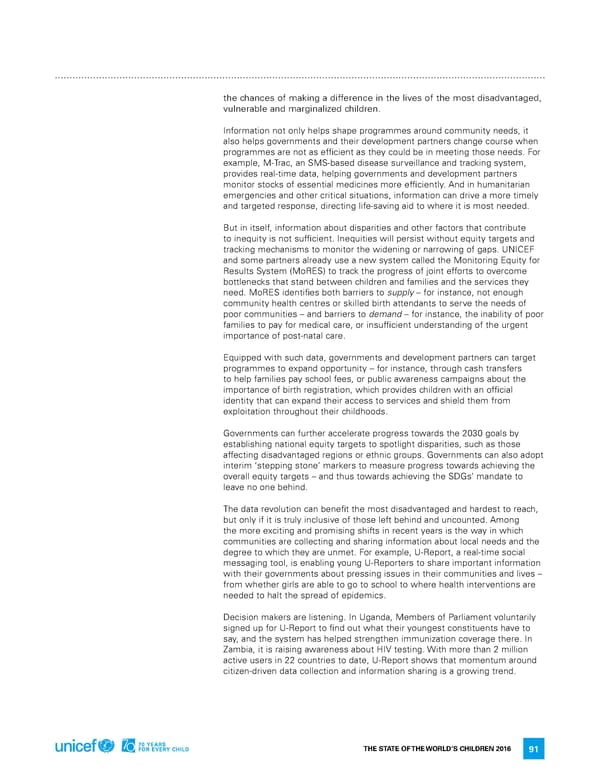the chances of making a difference in the lives of the most disadvantaged, vulnerable and marginalized children. information not only helps shape programmes around community needs, it also helps governments and their development partners change course when programmes are not as efficient as they could be in meeting those needs. f or example, M-Trac, an SMS-based disease surveillance and tracking system, provides real-time data, helping governments and development partners monitor stocks of essential medicines more efficiently. and in humanitarian emergencies and other critical situations, information can drive a more timely and targeted response, directing life-saving aid to where it is most needed. But in itself, information about disparities and other factors that contribute to inequity is not sufficient. inequities will persist without equity targets and tracking mechanisms to monitor the widening or narrowing of gaps. UniCef and some partners already use a new system called the Monitoring equity for results System (MoreS) to track the progress of joint efforts to overcome bottlenecks that stand between children and families and the services they need. MoreS identifies both barriers to supply – for instance, not enough community health centres or skilled birth attendants to serve the needs of poor communities – and barriers to demand – for instance, the inability of poor families to pay for medical care, or insufficient understanding of the urgent importance of post-natal care. equipped with such data, governments and development partners can target programmes to expand opportunity – for instance, through cash transfers to help families pay school fees, or public awareness campaigns about the importance of birth registration, which provides children with an official identity that can expand their access to services and shield them from exploitation throughout their childhoods. Governments can further accelerate progress towards the 2030 goals by establishing national equity targets to spotlight disparities, such as those affecting disadvantaged regions or ethnic groups. Governments can also adopt interim ‘stepping stone’ markers to measure progress towards achieving the overall equity targets – and thus towards achieving the SdGs’ mandate to leave no one behind. The data revolution can benefit the most disadvantaged and hardest to reach, but only if it is truly inclusive of those left behind and uncounted. among the more exciting and promising shifts in recent years is the way in which communities are collecting and sharing information about local needs and the degree to which they are unmet. for example, U-report, a real-time social messaging tool, is enabling young U-reporters to share important information with their governments about pressing issues in their communities and lives – from whether girls are able to go to school to where health interventions are needed to halt the spread of epidemics. decision makers are listening. in Uganda, Members of Parliament voluntarily signed up for U-report to find out what their youngest constituents have to say, and the system has helped strengthen immunization coverage there. in Zambia, it is raising awareness about hiV testing. With more than 2 million active users in 22 countries to date, U-report shows that momentum around citizen-driven data collection and information sharing is a growing trend. The STaTe of The World’S Children 2016 91
 70 Years for Every Child Page 108 Page 110
70 Years for Every Child Page 108 Page 110